
O p e r a t i n g G u i d e
Bandit ??112
Studio Pro?? 112
Envoy??110

O p e r a t i n g G u i d e
Bandit ??112
Studio Pro?? 112
Envoy??110
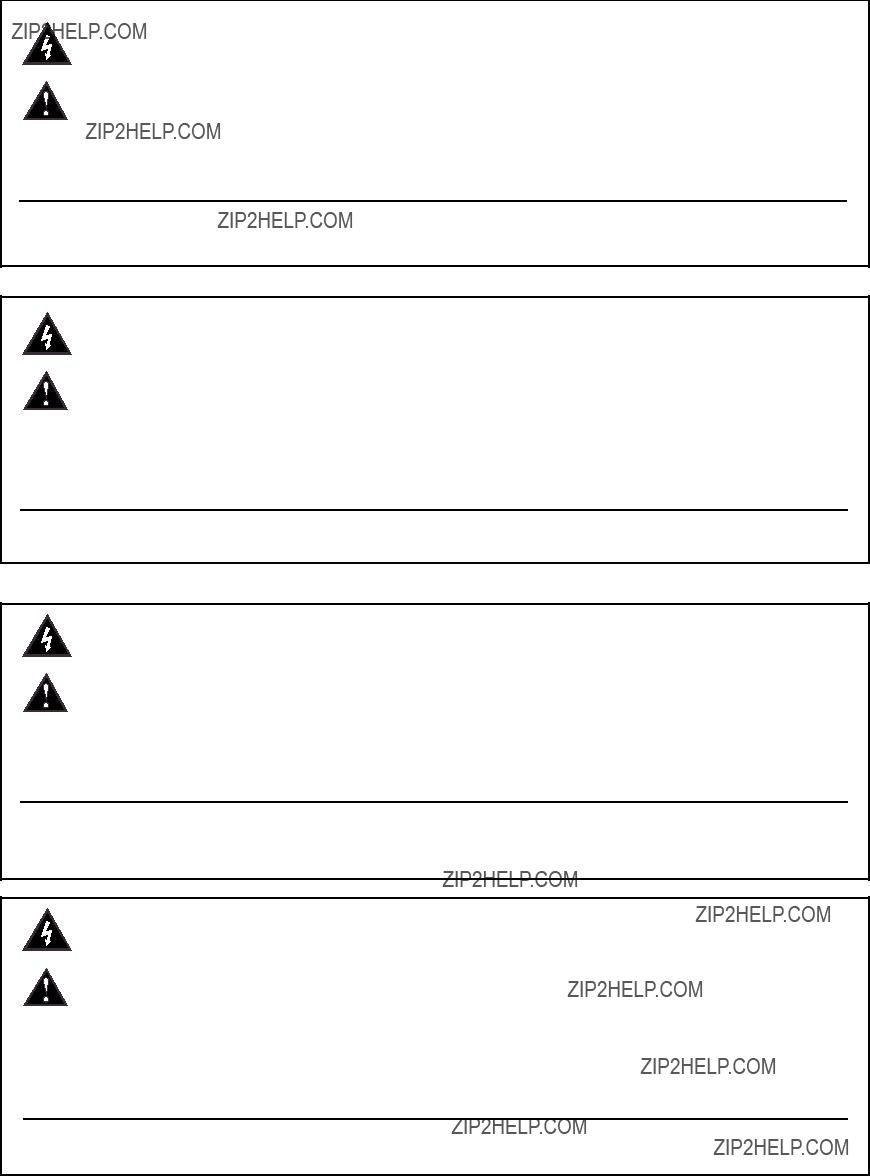
Intended to alert the user to the presence of uninsulated ???dangerous voltage??? within the product???s enclosure that may be of sufficient magnitude to constitute a risk of electric shock to persons.
Intended to alert the user of the presence of important operating and maintenance (servicing) instructions in the literature accompanying the product.
CAUTION: Risk of electrical shock ??? DO NOT OPEN!
CAUTION: To reduce the risk of electric shock, do not remove cover. No user serviceable parts inside. Refer servicing to qualified service personnel.
WARNING: To prevent electrical shock or fire hazard, do not expose this appliance to rain or moisture. Before using this appliance, read the operating guide for further warnings.
Este s??mbolo tiene el prop??sito, de alertar al usuario de la presencia de ???(voltaje) peligroso??? sin ais- lamiento dentro de la caja del producto y que puede tener una magnitud suficiente como para constituir riesgo de descarga el??ctrica.
Este s??mbolo tiene el prop??sito de alertar al usario de la presencia de instruccones importantes sobre la operaci??n y mantenimiento en la informaci??n que viene con el producto.
PRECAUCION:Riesgo de descarga el??ctrica ??NO ABRIR!
PRECAUCION:Para disminu??r el riesgo de descarga el??ctrica, no abra la cubierta. No hay piezas ??tiles dentro. Deje todo mantenimiento en manos del personal t??cnico cualificado.
ADVERTENCIA:Para evitar descargas el??ctricas o peligro de incendio, no deje expuesto a la lluvia o humedad este aparato Antes de usar este aparato, Iea m??s advertencias en la gu??a de operaci??n.
Ce symbole est utilis?? dans ce manuel pour indiquer ?? l???utilisateur la pr??sence d???une tension dangereuse pouvant ??tre d???amplitude suffisante pour constituer un risque de choc ??lectrique.
Ce symbole est utilis?? dans ce manuel pour indiquer ?? l???utilisateur qu???il ou qu???elle trouvera d???importantes instructions concernant l???utilisation et l???entretien de l???appareil dans le paragraphe signal??.
ATTENTION: Risques de choc ??lectrique ??? NE PAS OUVRIR!
ATTENTION: Afin de r??duire le risque de choc ??lectrique, ne pas enlever le couvercle. Il ne se trouve ?? l???int??rieur aucune pi??ce pouvant ??tre repar??e par l???utilisateur. Confiez I???entretien et la r??paration de l???appareil ?? un r??parateur Peavey agr????.
AVERTISSEMENT: Afin de pr??venir les risques de d??charge ??lectrique ou de feu, n???exposez pas cet appareil ?? la pluie ou ?? l???humidit??. Avant d???utiliser cet appareil, lisez attentivement les avertissements suppl??mentaires de ce
manuel.
Dieses Symbol soll den Anwender vor unisolierten gef??hrlichen Spannungen innerhalb des Geh??uses warnen, die von Ausreichender St??rke sind, um einen elektrischen Schlag verursachen zu k??nnen.
Dieses Symbol soll den Benutzer auf wichtige Instruktionen in der Bedienungsanleitung aufmerksam machen, die Handhabung und Wartung des Produkts betreffen.
VORSICHT: Risiko ??? Elektrischer Schlag! Nicht ??ffnen!
VORSICHT: Um das Risiko eines elektrischen Schlages zu vermeiden, nicht die Abdeckung enfernen. Es befinden sich keine Teile darin, die vom Anwender repariert werden k??nnten. Reparaturen nur von qualifiziertem
Fachpersonal durchf??hren lassen.
ACHTUNG: Um einen elektrischen Schlag oder Feuergefahr zu vermeiden, sollte dieses Ger??t nicht dem Regen oder Feuchtigkeit ausgesetzt werden. Vor Inbetriebnahme unbedingt die Bedienungsanleitung lesen.
2

ENGLISH
Envoy?? 110, Studio?? Pro 112 and Bandit?? 112
TransTube?? Series Instrument Amplifiers
Congratulations on your purchase of a Peavey TransTube?? Series instrument amplifier. Whether you are a beginner or seasoned pro, you could not have found a more practical,
Three TransTube Series models are described in this book due to their similarities. These models are the Envoy?? 110, Studio Pro?? 112 and Bandit?? 112. Where applicable, the differences in the units are noted. The lists below describe the main features and differences between the amps. Please read this manual in its entirety to ensure optimum and safe operation of your new TransTube amp.
COMMON FEATURES
???High and Low Gain Inputs to accommodate a variety of instruments
???Two distinct TransTube channels each featuring:
???Separate Volume/Gain controls
???Low, Mid and High EQ
???EQ/Gain voicing switches
???Channel select switch on front panel
???Spring reverb with reverb level control
???Remote footswitch capability
ENVOY 110 FEATURES
???10" Blue Marvel?? speaker
???40 watt power amplifier
???Preamp output
???Headphone jack
???Footswitchable reverb and channel selection
STUDIO PRO 112 FEATURES
???12" Blue Marvel speaker
???65 watt power amplifier
???Effects send and return
???T. Dynamics?? control
???External speaker jack
???Footswitchable reverb and channel selection
BANDIT 112 FEATURES
???12" Sheffield?? 1230 speaker
???100 watt power amplifier (80 watts into internal speaker)
???Footswitchable effects loop and channel selection
???Effects level switch
???Preamp output
???Power amp input
???External speaker jack
???
???Presence control
???Resonance switch
3
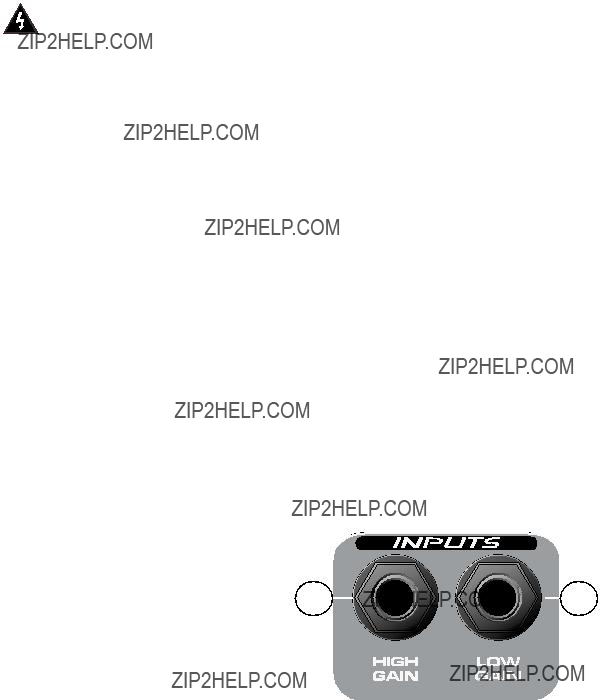
AC POWER
In order to apply power to your TransTube Series amp you must first identify its required AC supply voltage. The proper voltage for your unit is labeled on the upper left corner of the rear panel.
1.AC Power Cord (Under Chassis)
Locate the power cord tucked into the rear speaker compartment. This line cord provides the
AC power to the unit. Connect the line cord to a properly grounded AC supply. Damage to the equipment may occur if improper line voltage is used. (See voltage marking on unit.) Never remove or cut the ground pin of the line cord plug.
NOTE: FOR UK ONLY
As the colors of the wires in the mains lead of this apparatus may not correspond with the colored markings identifying the terminals in your plug, proceed as follows: (1) The wire which is colored green and yellow must be connected to the terminal which is marked by the letter E, or by the earth symbol, or colored green or green and yellow. (2) The wire which is colored blue must be connected to the terminal which is marked with the letter N, or the color black. (3) The wire which is colored brown must be connected to the terminal which is marked with the letter L or color red.
2.Power Switch (See Master Section Diagram page 7.)
Press this switch to the ???ON??? position to apply power. The Power LED (3) will illuminate to indicate the unit is on. Pressing the bottom portion of the switch will turn the amp off.
3.Power LED (See Master Section Diagram page 7.) This LED will illuminate to indicate the amp is on.
TRANSTUBE PREAMP
The TransTube preamp on your amplifier consists of three clearly labeled sections: Inputs, Clean (channel) and Lead (channel). Let???s look at each of these areas individually.
Inputs
The inputs of your TransTube Series amplifier are tailored to respond exactly like the inputs found on popular tube amplifiers. Always use quality, shielded instrument cables when connecting your instrument to the input.
4.High Gain Input
This is the standard input used for most instrument applications. Most electric guitars will work ideally when plugged into this 1/4" mono input. The High Gain Input is 6 dB louder than the Low Gain Input (5).
5.Low Gain Input
This 1/4" mono input is provided for instruments with extremely high outputs, which can result in overdriving (distorting) the High Gain Input (4). If both the Low Gain and High Gain inputs are used simultaneously, their levels are both Low Gain.
4
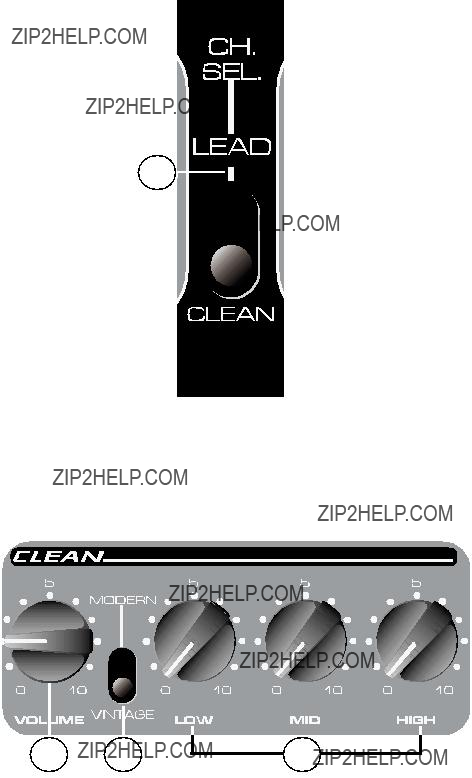
CHANNELS
Your TransTube Series amp offers
6
6.Channel Select Switch
The Channel Select Switch determines which channel of the TransTube Preamp, LEAD or CLEAN, is active. This switch must be in the ???LEAD??? position in order for the footswitch function of your amp to work.
CLEAN CHANNEL
7.Volume
This control sets the volume level for the Clean channel. It is best to start with the control fully counterclockwise (minimum gain) and adjust clockwise until the desired level is achieved. After all EQ and voicing adjustments have been made to the channel, you may wish to reset this control.
8.Modern/Vintage Switch
This switch allows you to instantly change the voicing to reflect the tones of modern and vintage amplifiers. The MODERN position maintains a warm, standard voicing. The VINTAGE
5
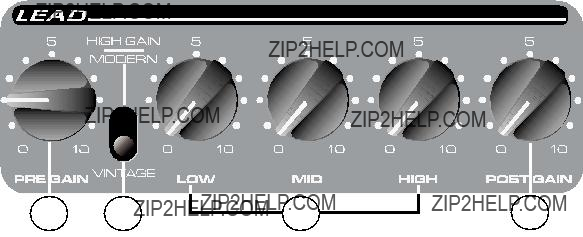
position changes the overall function of the EQ and adds a hint of brightness to emulate some classic amp designs. Experiment with this switch, along with Clean EQ (9) adjustments, to capture your desired tone. You may refer to the Recommended Settings on page 11 for some creative starting points.
9.Clean EQ
The TransTube EQ featured on the Clean channel of your amp offers
LEAD CHANNEL
10.Pre Gain
The Pre Gain control sets the input level of the Lead channel. Adjusting this control fully clockwise will result in maximum gain. This control is often used to adjust the amount of distortion present in the Lead channel.
11.Modern/Vintage/High Gain- Switch
This switch changes both the gain and voicing of the Lead channel. Selecting the MODERN setting increases the overall gain and notches (cuts) the mid frequencies to establish a modern tone often associated with Hard Rock and Metal styles. The VINTAGE position uses the TransTube circuitry to emulate overdriven tube sounds of the past. The HIGH GAIN setting increases the overall gain and changes the EQ. This creates a tighter response at lower Pre Gain settings or an ???over the top??? sound at higher Pre Gain settings. Experiment with this switch setting while adjusting the Lead EQ (12) to help you obtain your desired tone. You may refer to the Recommended Settings on page 11 for some creative starting points.
12.Lead EQ
The TransTube EQ featured on the Lead channel of your amp offers
6

13.Post Gain
Use this control to set the overall level of the Lead channel once your tone has been achieved. It is best to start with the control fully counterclockwise (minimum gain) and adjust clockwise until the desired level is achieved. After all EQ and voicing adjustments have been made to the channel, you may wish to reset this control.
MASTER SECTION
The Master sections of the TransTube Series amps vary from unit to unit. Please read carefully. Each feature???s description identifies its applicable model(s).
14.Reverb
The Reverb control adjusts the overall reverb level. This control is found on all three models.
Note: Reverb can be defeated by the Remote Switch (18) on the Envoy 110 and Studio Pro 112 models.
15.
This control adjusts the power level of the amplifier from 10 percent to 100 percent power. When set to lower settings, the power compression simulation will be much more pronounced. This control is found on the Studio Pro 112 and Bandit 112.
16.Presence
This active tone control boosts the extreme high frequencies by as much as 6 dB. This control is found on Bandit 112 only.
17.Resonance
Use this switch to set the low frequency resonance of the speaker enclosure by varying the damping factor of the amplifier between two settings, TIGHT and LOOSE. In the TIGHT position, the amlifier has a higher damping factor causing the speaker/cabinet combination to resonate less.The LOOSE position allows the characteristics of the power amp/cabinet/speaker combination to resonate more at low frequencies. Thus, the resonant frequency of the cabinet is used to produce more low end, simulating a larger cabinet. This control is found on the Bandit 112 only.
7
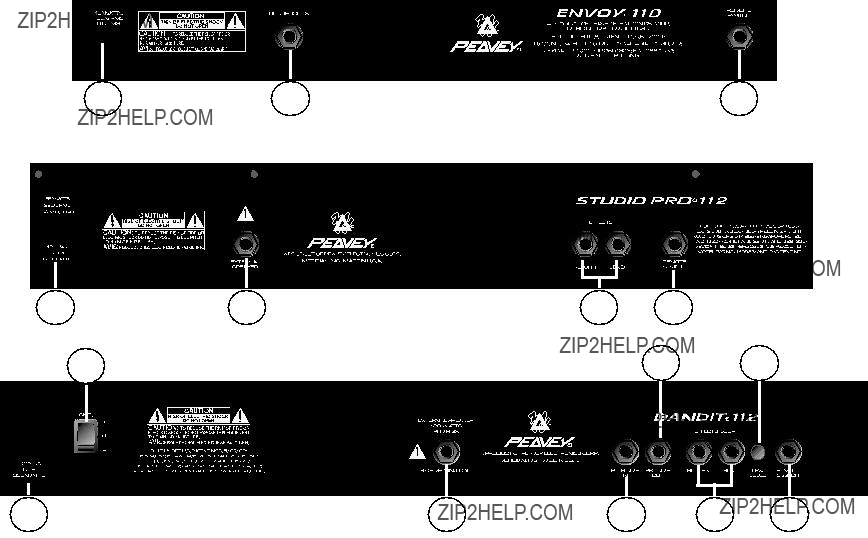
REAR PANEL
The rear panel features of the TransTube Series amps vary from unit to unit. Please read each carefully. Each feature???s description identifies its applicable model(s).
18.Remote Switch
This jack accepts the appropriate remote footswitch for your amp. The footswitch (optional on Envoy 110 and Studio Pro 112) is a
19.Headphones Jack
This stereo 1/4" jack accepts a standard pair of headphones. Using this jack defeats the output to the speaker making it ideal for quiet practice applications. This jack is featured on the Envoy 110 only.
NOTE: The remaining features apply to the Studio Pro 112 and/or the Bandit 112 models only.
20.Effects Loop
This pair of mono 1/4" jacks supply an effects SEND and RETURN path for the preamp signal. Connect the SEND jack to the input of external,
8
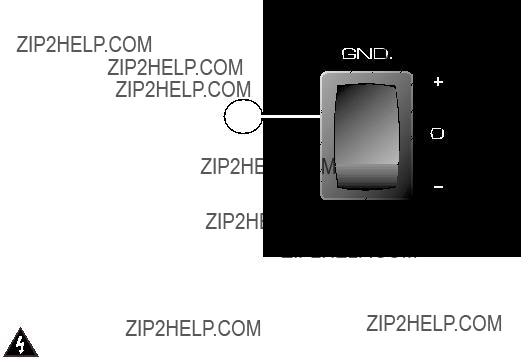
21.External Speaker Jack
This 1/4" jack is provided for the connection of an external speaker cabinet such as the Peavey 412M. The minimum external speaker impedance is 8 ohms. This jack disconnects internal speaker when used on Studio Pro 112
NOTE: The remaining features apply to the Bandit 112 model only.
22.Preamp Out
The Preamp Output can be used to route the preamp signal to a mixing console, tape recorder, etc. Using a shielded instrument cable with mono 1/4" plugs, connect the Preamp Output to the input of your outboard equipment. This patch will not affect the normal operation of your amplifier.
23.Power Amp In
Connect line level signals from external equipment to this input. Inserting a plug into this mono 1/4" jack will prevent the TransTube preamp signal from being sent to the amplifier. In this configuration, the power amp only amplifies the signal introduced at the Power Amp In jack.
24.Effects Level
This switch selects the Effects Loop (20) operating level. When the switch is pressed to the ???in??? position the level is set for 0 dBV (1 V RMS). Placing the switch to the ???out??? position changes the level to
25
25.Ground Switch
Place this switch in the center position (0) during normal operation. If audible hum occurs,
position the ground switch in either the positive (+) or negative
NOTE: Should the noise problem continue, consult an Authorized Peavey Dealer or Peavey Repair Center. THE GROUND SWITCH IS NOT FUNCTIONAL ON 220/240 VOLT MODELS.
9

Envoy?? 110, Studio?? Pro 112 and Bandit?? 112,
Level Diagram
10

RECOMMENDED SETTINGS



















 **
**
Your Preference
NOTE: The Bandit 112 is used for demonstration purposes. The settings illustrated above are also applicable to the Envoy 110 and Studio Pro 112, with the exception of the resonance and presence controls.
11
ENVOY?? 110
SPECIFICATIONS
POWER AMPLIFIER SECTION:
Power @ Clipping: (Typically)
(5% THD, 1 kHz, 120V AC line)
40W RMS into 6 Ohms
Frequency Response:
+0,
Hum and Noise:
Greater than
Power Consumption:
75W @ 60 Hz, 120V AC, Domestic
75W @ 50/60 Hz,
PREAMP SECTION:
The following specs are measured @ 1 kHz with the controls preset as follows:
Channel Select, Clean Clean Mode Switch, Modern Low and High @ 10
Mid @ 0
Lead Pre and Post Gain @ 10 Lead Mode Switch, Vintage Reverb @ 0
Nominal Levels are with Clean Volume @ 5 Minimum Levels are with Clean Volume @ 10
Preamp Low Gain Input:
Impedance: High Z, 44k Ohms
Nominal Input Level:
Minimum Input Level:
Maximum Input Level: +6dBV, 2V RMS
Headphone Output:
Load Impedance: 16 Ohms or greater
Nominal Output Level:
System Hum and Noise @ Nominal Input Level:
(20 Hz to 20 kHz unweighted)
Greater than 78 dB below rated power
Equalization:
Special Low, Mid, and High passive type EQ. Modern/Vintage switch (Clean):
Two distinct EQ voicings. Vintage/Modern/High Gain switch (Lead): Three different EQ and Gain voicings
External Footswitch Functions:
Select: Clean or Lead channel selection.
Reverb: Reverb bypass
Dimensions (H x W x D):
16??? H x 18.13??? W x 9.5??? D 40.1cm x 46.1cm x 24.1cm
Specifications subject to change without notice.
12
STUDIO?? PRO 112
SPECIFICATIONS
POWER AMPLIFIER SECTION:
Rated Power and Load:
Power specs measured with
Power @ Clipping: (Typically)
(5% THD, 1 kHz, 120V AC line)
65W RMS into 8 Ohms
Frequency Response:
+3,
Hum and Noise:
Greater than 88 dB below rated power
Power Consumption:
200W @ 60 Hz, 120V AC, Domestic
200W @ 50/60 Hz,
PREAMP SECTION:
The following specs are measured @ 1 kHz with the controls preset as follows:
Channel Select, Clean Clean Mode Switch, Modern Low and High @ 10
Mid @ 0
Lead Pre and Post Gain @ 10 Lead Mode Switch, Vintage Reverb @ 0
Nominal Levels are with Clean Volume @ 5 Minimum Levels are with Clean Volume @ 10
Preamp Low Gain Input:
Impedance: High Z, 44 k Ohms
Nominal Input Level:
Minimum Input Level:
Maximum Input Level: +6 dBV, 2V RMS
Effects Send:
Load Impedance: 1k Ohms or greater Nominal Output Level:
Effects Level
Effects Return:
Impedance: High Z, 22k Ohms Designed Input Level:
Effects Level
System Hum and Noise @ Nominal Input Level:
(20Hz to 20kHz unweighted)
Greater than 74dB below rated power
Equalization:
Special Low, Mid, and High passive type EQ Modern/Vintage switch (Clean): Two distinct
EQ voicings Vintage/Modern/High Gain switch (Lead):
Three different EQ and Gain voicings
External Footswitch Functions:
Select: Clean or Lead channel selection
Reverb: Reverb bypass
Specifications subject to change without notice.
13
BANDIT?? 112
SPECIFICATIONS
POWER AMPLIFIER SECTION:
Rated Power and Load:
Power specs measured with
100W RMS into 4 Ohms
Power @ Clipping: (Typically)
(5% THD, 1 kHz, 120V AC line)
80W RMS into 8 Ohms
100W RMS into 4 Ohms
Frequency Response:
+0,
Hum and Noise:
Greater than 88 dB below rated power
Power Consumption:
300W @ 60 Hz, 120V AC, Domestic
300W @ 50/60 Hz,
PREAMP SECTION:
The following specs are measured @ 1 kHz with the controls preset as follows:
Channel Select, Clean Clean Mode Switch, Modern Low and High @ 10
Mid @ 0
Lead Pre and Post Gain @ 10 Lead Mode Switch, Vintage Reverb @ 0
Nominal Levels are with Clean Volume @ 5 Minimum Levels are with Clean Volume @ 10
Preamp High Gain Input:
Impedance: High Z, 250 K Ohms
Nominal Input Level:
Minimum Input Level:
Maximum Input Level: +0 dBV, 1V RMS
Preamp Low Gain Input:
Impedance: High Z, 44 k Ohms
Nominal Input Level:
Minimum Input Level:
Maximum Input Level: +6 dBV, 2 V RMS
Effects Send:
Load Impedance: 1 k Ohms or greater Nominal Output Level:
Effects Level switch ???out???:
Effects Level switch ???in???: 0 dBV, 1V RMS
Effects Return:
Impedance: High Z, 22k Ohms Designed Input Level:
Effects Level switch ???out???:
Effects Level switch ???in???: 0dBV, 1V RMS (Switching jack provides Effects Send to Effects Return connection when not used.)
Preamp Output:
Load Impedance: 1 k Ohms or greater
Nominal Output Level: 0 dBV, 1V RMS
Power Amp Input:
Impedance: High Z, 22k Ohms
Designed Input Level: 0 dBV, 1V RMS (Switching jack provides preamp output to power amp input connection when not used.)
System Hum and Noise @ Nominal Input Level:
(20 Hz to 20 kHz unweighted) Greater than 78 dB below rated power
Equalization:
Special Low, Mid, and High passive type EQ Modern/Vintage switch (Clean): Two distinct
EQ voicings Vintage/Modern/High Gain switch (Lead): Three different EQ and Gain voicings Presence: +6 dB @ 5 kHz
Push Resonance: +6 dB @ resonant frequency of cabinet
External Footswitch Functions:
Select: Clean or Lead channel selection
Effects: Effects loop bypass
Dimensions (H x W x D):
19.75" x 23.63" x 11.5" 50.16cm x 60.02cm x 29.2cm
Weight:
43.9lbs. (19.91kg)
Specifications subject to change without notice.
14

ESPA??OL
Envoy?? 110, Studio Pro?? 112 y Bandit?? 112
de la Serie Transtube?? de Amplificadores para Instrumentos
Felicitaciones por la compra de un amplificador para instrumento de la serie Transtube de Peavey. Seas un principiante o un profesional consagrado, no podr??as haber encontrado un amplificador m??s pr??ctico y con mejores caracter??sticas. Los circuitos patentados Transtube de Peavey han avanzado a la segunda generaci??n de productos, siendo los primeros en la industria en emulaci??n de bulbos. No hay otro amplificador de estado s??lido que replique de manera m??s precisa las caracter??sticas de un amplificador de bulbos.
Tres modelos de la Serie Transtube son descritos en este libro debido a sus similitudes. Estos modelos son el Envoy?? 110, StudioPro?? 112 y Bandit?? 112. En los lugares apropiados, las diferencias entre las unidades son marcadas. Las listas que siguen describen las caracter??sticas principales y las diferencias entre los amplis. Por favor lee este manual completamente para asegurar una ??ptima y segura operaci??n de tu nuevo ampli Transtube.
CARACTER??STICAS COMUNES
???Entradas de ganancia alta y baja para acomodar una variedad de instrumentos
???Dos canales Transtube distintivos que presentan:
???Controles separados de volumen/ganancia
???Ecualizador de graves, medios y agudos
???Switches de ecualizaci??n/voces de ganancia
???Switch de selecci??n de canal en el panel frontal
???Reverb de resorte con control de nivel de reverb
???Capacidad de uso de pedal remoto
CARACTER??STICAS DEL ENVOY 110
???Bocina Blue Marvel?? de 10"
???Amplificador de poder de 40 Wats
???Salida de preamplificador
???Entrada para aud??fonos
???Selecci??n de reverb y canal por medio de pedal
CARACTER??STICS DEL STUDIO PRO 112
???Bocina Blue Marvel de 12"
???Amplificador de poder de 65 Wats
???Env??o y retorno para efectos
???Control de
???Conexi??n para bocinas externas
???Selecci??n de reverb y canal por medio de pedal
CARACTER??STICAS DEL BANDIT 112
???Bocina Sheffield?? 1230 de 12"
???Amplificador de poder de 100 Wats (80 Wats hacia la bocina interna)
???Selecci??n de Circuito de efectos y canal por medio de pedal
???Switch de nivel de efectos
15

???Salida de preamplificador
???Entrada para amplificador de poder
???Conexi??n para bocinas externas
???Control
???Control de presencia
PODER DE CORRIENTE ALTERNA
Para poder aplicar poder a tu amplificador de la Serie Transtube, primero debes identificar su suministro de voltaje de CA. El voltaje apropiado para tu unidad est?? rotulado en la esquina superior izquierda del panel trasero.
1.Cable de Poder de CA (Debajo del Chasis)
Localiza el cable de poder que est?? guardado en el compartimento de bocina trasero. Este
cable suministra el poder de CA a la unidad. Conecta el cable a un suministro de CA propiamente aterrizado. El equipo puede ser da??ado si se usa un voltaje de l??nea incorrecto (ver marcaci??n de voltaje en la unidad). Nunca quites o cortes la aguja de tierra del conector del cable.
2.Switch de Poder (Ver diagrama de la Secci??n Maestra en la p??gina 7)
Oprime el switch a la posici??n "ON" para aplicar poder. El LED de poder (3) se iluminar?? para indicar que la unidad est?? encendida. El oprimir la porci??n inferior del switch apagar?? el amplificador.
3.LED de Poder (ver diagrama de la Secci??n Maestra en la p??gina 7)
LED se iluminar?? para indicar que el ampli est?? encendido.
PREAMPLIFICADOR TRANSTUBE
El preamplificador Transtube de tu amplificador consiste de tres secciones claramente rotuladas: Inputs, Clean (limpio) y Lead. Veamos cada una de estas ??reas individualmente.
Entradas
Las entradas de tu amplificador de la Serie Transtube est??n dise??adas para responder exactamente como las entradas de los amplificadores de bulbos populares. Siempre usa cables protegidos de calidad cuando conectes tu instrumento a la entrada.
4.Entrada de Alta Ganancia
??sta es la entrada est??ndar usada para la mayor??a de las aplicaciones con instrumento. La mayor??a de las guitarras el??ctricas funcionar??n de manera ??ptima al conectarlas a esta entrada monof??nica de un 1/4". La entrada de alta ganancia es 6 dB m??s fuerte que la entrada de baja ganancia (5).
16
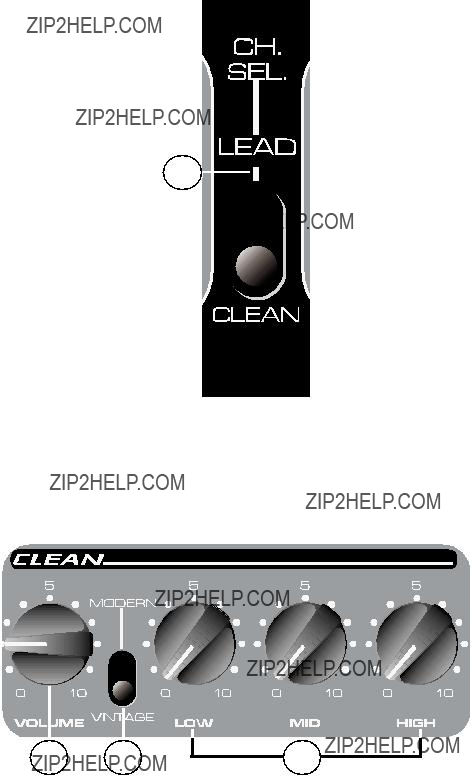
5.Entrada de Baja Ganancia
Esta entrada monof??nica de 1/4" se incluye para instrumentos con salidas extremadamente altas, lo que puede resultar en una distorsi??n de la entrada de alta ganancia (4). Si se usan simult??neamente las entradas de alta y baja ganancia, los niveles de ambas son de baja ganancia.
CANAL
Tu ampli de la Serie Transtube ofrece operaci??n a dos canales. Tanto el canal ???clean??? como el ???lead??? proveen una plataforma flexible para que establezcas tu tono favorito. El pedal (opcional en el Envoy 110 y Studio Pro 112) te permite controlar los dos canales de manera remota y es explicado en detalle en la p??gina 8 de esta gu??a.
6
6.Switch de Selecci??n de Canal
El switch de Selecci??n de Canal determina qu?? canal del preampli Transtube, LEAD o CLEAN, est?? activo. Este switch debe estar en la posici??n ???LEAD??? para que la funci??n del pedal de tu ampli funcione.
CANAL LIMPIO (CLEAN)
7.Volumen
Este control ajusta el nivel de volumen para el canal limpio. Lo m??s recomendable es empezar con el control girado totalmente hacia la izquierda (ganancia m??nima) y ajustarlo
17
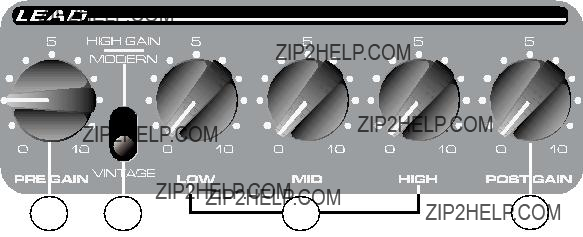
hacia la derecha hasta lograr el nivel deseado. Despu??s de hacer todos los ajustes de ecualizaci??n y voces en el canal, tal vez querr??s reajustar este control.
8.Switch Modern/Vintage
Este switch te permite cambiar instant??neamente el tono para emular amplificadores modernos y cl??sicos. La posici??n MODERN mantiene un tono c??lido y est??ndar. La posici??n VINTAGE cambia la funci??n general de la ecualizaci??n a??adiendo algo de brillo y emulando algunos dise??os de amplis cl??sicos. Experimenta con este switch, junto con ajustes de ecualizaci??n limpia (9), para capturar tu tono deseado. Puedes referirte a los Ajustes Recomendados de la p??gina 11 para obtener algunos puntos de partida creativos.
9.Ecualizaci??n Limpia
El ecualizador Transtube en el canal limpio de tu ampli ofrece ajuste de tono a tres bandas. Cada control de ecualizaci??n es pasivo (no ofrece ganancia) y tiene un rango de frecuencia que depende de la posici??n del switch Modern/Vintage. Si reduces el control a la posici??n ???0??? (totalmente hacia la izquierda) introducir??s el m??ximo corte de nivel para esa banda en particular. Est??n disponibles bandas para ajuste de graves, medios y agudos.
CANAL L??DER
10.Pre Ganancia
El control de Pre Ganancia controla el nivel de entrada del canal l??der. Ajustar este control totalmente hacia la derecha resultar?? en una m??xima ganancia. Este control es usado com??nmente para ajustar la cantidad de distorsi??n presente en el canal l??der.
11.Switch Modern/Vintage/High Gain
Este switch cambia tanto la ganancia como el tono del canal l??der. Si lo ajustas a MODERN, se incrementa la ganancia general y se cortan las frecuencias medias para establecer un tono moderno com??nmente asociado con los estilos Hard Rock y Metal. La posici??n VINTAGE usa los circuitos Transtube para emular los sonidos distorsionados creados con bulbos en ??pocas pasadas. La posici??n HIGH GAIN incrementa la ganancia general y cambia la ecualizaci??n. Esto crea una respuesta m??s ???apretada??? en las posiciones m??s bajas de preganancia, o un sonido exagerado en las posiciones m??s altas de preganancia. Experimenta con los ajustes de este switch y usa el ecualizador l??der (12) al mismo tiempo para ayudarte a obtener el tono deseado. Puedes referirte a los Ajustes Recomendados de la p??gina 11 para obtener algunos puntos de partida creativos.
12.Ecualizador L??der
El ecualizador Transtube en el canal l??der de tu ampli ofrece ajuste de tono a tres bandas. Cada control de ecualizaci??n es pasivo (no ofrece ganancia) y tiene un rango de frecuencia
18

que depende de la posici??n del switch Modern/Vintage. Si reduces el control a la posici??n ???0??? (totalmente hacia la izquierda) introducir??s el m??ximo corte de nivel para esa banda en particular. Est??n disponibles bandas para ajuste de graves, medios y agudos.
13.Post Ganancia
Usa este control para ajustar el nivel de canal l??der una vez que tu tono haya sido logrado. Lo m??s recomendable es empezar con el control totalmente hacia la izquierda y ajustarlo hacia la derecha hasta alcanzar el nivel deseado. Despu??s de hacer los ajustes de ecualizaci??n y tono en el canal, puedes regresar este control a su posici??n original.
SECCI??N MAESTRA
Las secciones maestras de los amplis de la Serie Transtube var??an de unidad a unidad. Por favor lee cuidadosamente la descripci??n de cada caracter??stica e identifica a los modelos aplicables.
14.Reverb
El control de reverb controla el nivel general de reverb. Este control se encuentra en los tres modelos. Nota: El reverb puede ser cancelado con el switch remoto (18) en el Envoy 110 y en el Studio Pro 112.
15.
Este control ajusta el nivel de poder del amplificador de 10 a 100% de poder. Al ajustarse a niveles menores, la simulaci??n de compresi??n de poder ser?? mucho m??s pronunciada. Este control se encuentra en los modelos Studio Pro 112 y Bandit 112.
16.Presencia
Este control activo de tono aumenta las frecuencias extremadamente agudas hasta por 6 dB. Este control s??lo se encuentra en el Bandit 112.
17.Resonancia
Usa este switch para ajustar la resonancia de bajas frecuencias de la bocina variando el factor de amortiguaci??n del amplificador entre dos valores, TIGHT y LOOSE. En la posici??n TIGHT el amplificador tiene un factor de amortiguaci??n mayor causando que la combinaci??n bocina/gabinete tenga una menor resonancia. La posici??n LOOSE permite que las caracter??sticas de la combinaci??n ampli de poder/gabinete/bocina tengan mayor resonancia en las frecuencias graves. Por lo tanto, la frecuencia resonante del gabinete es usada para producir mayor cantidad de graves, simulando as?? un gabinete m??s grande. Este control se encuentra solamente en el Bandit 112.
19

PANEL TRASERO
Las caracter??sticas del panel trasero de los amplis de la Serie Transtube var??an de unidad a unidad. Por favor lee cuidadosamente la descripci??n de cada caracter??stica e identifica a los modelos aplicables.
18.Switch Remoto
Esta entrada recibe al pedal apropiado para tu amplificador. El pedal (opcional en los modelos Envoy 110 y Studio Pro 112) es del tipo multifuncional. Se usa para alternar entre los canales Limpio y L??der. Adem??s, el pedal es usado para activar/desactivar el reverb en los modelos Envoy 110 y Studio Pro 112. En el modelo Bandit, el pedal (incluido) provee selecci??n de canal y cancelaci??n del Circuito de Efectos (20). El Switch de Selecci??n de Canal (6) debe estar en la posici??n LEAD para que el Switch Remoto funcione.
19.Entrada de Aud??fonos
Esta entrada de 1/4" sirve para un par est??ndar de aud??fonos. Al usar esta entrada, la salida hacia las bocinas se cancela, haci??ndola ideal para ensayo silencioso. Esta entrada s??lo est?? disponible en el Envoy 110.
NOTA: Las caracter??sticas siguientes s??lo se aplican a los modelos Studio Pro 112 y/o Bandit 112.
20.Circuito de Efectos
Este par de entradas monof??nicas de 1/4" suministran una v??a para ENV??O y RETORNO (SEND y RETURN) de efectos para la se??al del preamplificador. Conecta la entrada SEND a la entrada externa de bajo nivel del equipo de procesamiento de se??al (efectos). Regresa la se??al de tu equipo externo a la entrada RETURN. Esto se conoce como Circuito de Efectos
20
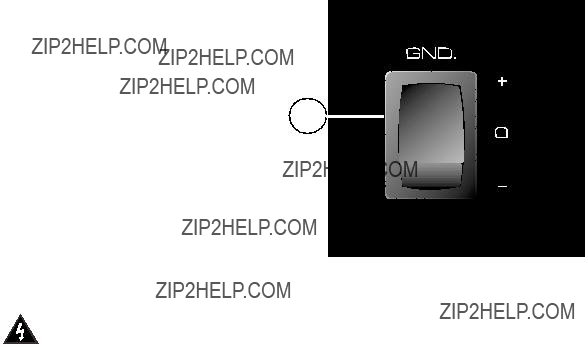
ya que la se??al sale de tu ampli (env??o) y regresa (retorno) a ??ste. En el Bandit 112, el circuito de efectos puede ser insertado, o no, en el paso de la se??al usando el Switch Remoto incluido (18).
21.Entrada para Bocina Externa
Esta entrada de 1/4" sirve para conectar una bocina externa como la 412M de Peavey. La m??nima impedancia para la bocina externa es de 8 ohmios. Esta entrada desconecta la bocina interna al usarse en el Studio Pro 112.
NOTA: Las caracter??sticas que siguen s??lo se encuentran en el Bandit 112.
22.Salida de preamplificador
La salida de preamplificador puede ser usada para enviar la se??al del preampli a una consola de mezcla, grabadora, etc. Usando un cable protegido y con conectores de 1/4", conecta la salida de preamplificador a la entrada de tu equipo externo. Esta conexi??n no afectar?? la operaci??n normal de tu amplificador.
23.Entrada de Amplificador de Poder
Conecta se??ales de nivel de l??nea de equipo externo a esta entrada. El insertar un conector a esta entrada monof??nica de 1/4" evitar?? que la se??al del preampli Transtube sea enviada al amplificador. En esta configuraci??n, el ampli de poder s??lo amplifica la se??al introducida en la entrada del ampli de poder.
24.Nivel de Efectos
Este switch selecciona el nivel de operaci??n del Circuito de Efectos (20) cuando el switch es presionado a la posici??n ???in??? el nivel es ajustado a 0 dBV (1 V RMS). Colocar el switch en la posici??n ???out??? cambia el nivel a
25
25.Switch de Tierra
Coloca este switch en la posici??n central (0) durante operaciones normales. Si ocurre una
vibraci??n o ???hum??? audible, coloca el switch de tierra ya sea en la posici??n positiva (+) o negativa
NOTA: Si el problema de ruido contin??a, consulta a un Vendedor Autorizado de Peavey o Centro de Reparaci??n Peavey. EL SWITCH DE TIERRA NO FUNCIONA EN LOS MODELOS DE 220/240 VOLTIOS.
21
ENVOY?? 110
ESPECIFICACIONES
SECCI??N DE AMPLIFICADOR DE PODER: Poder en distorsi??n: (Normalmente)
(5% THD, 1 kHz, 120V l??nea CA)
40W RMS a 6 Ohmios
Respuesta de Frecuencias:
+0,
???Hum??? y Ruido:
Mayor que
Consumo de Poder:
75W @ 60 Hz, 120V CA, Dom??stico
75W @ 50/60 Hz,
Exportaci??n
SECCI??N DEL PREAMPLI:
Las especificaciones que siguen est??n marcadas @ 1 kHz con los controles ajustados como sigue:
Selecci??n de canal, limpio Switch Modo Limpio, Moderno Graves y Agudos @ 10 Medios @ 0
Pre and Post Ganancia L??der @ 10 Switch Modo L??der, ???Vintage??? Reverb @ 0
Niveles Nominal son con Volumen Limpio @ 5
Niveles M??nimum son con Volumen Limpio @ 10
Entrda de Preampli de Baja Ganancia:
Impedancia: ???High Z???, 44k Ohmios
Nivel Nominal de Entrada:
Nivel M??nimo de Entrada:
Nivel M??ximo de Entrada: +6dBV, 2V RMS
Salida de Aud??fonos:
Impedancia de Carga: 16 Ohmios o mayor
Nivel Nominal de Salida:
???Hum??? y Ruido del sistema @ Nivel Nominal de Entrada: (20 Hz a 20 kHz sin peso)
Mayor que 78 dB debajo del poder marcado
Ecualizaci??n:
Ecualizador Pasivo Especial para graves, medios, agudos.
Switch Modern/Vintage (Limpio): Dos voces distintivas de Ecualizaci??n.
Switch de ganancia Vintage/Modern/High (L??der):
Tres diferentes Ecualizaciones y Ganancias
Funciones del Pedal Externo:
Selecci??n: Selecci??n de Canal Limpio o L??der
Reverb: cancelaci??n de Reverb
22
STUDIO?? PRO 112
ESPECIFICACIONES
SECCI??N DEL AMPLIFICADOR DE PODER:
Poder y Carga Clasificados:
Especificaciones de Poder Marcadas con
65W RMS a 8 Ohmios
Poder en Saturaci??n (Normalmente)
(5% THD, 1 kHz, 120V CA l??nea)
65W a 8 Ohmios
Respuesta de Frecuencias:
+3,
Entrada de Preampli de Baja Ganancia:
Impedancia: High Z, 44 k Ohmios
Nivel Nominal de Entrada:
Nivel M??nimo de Entrada:
Nivel M??ximo de Entrada: +6 dBV, 2V RMS
Env??o de Efectos:
Carga de Impedancia: 1k Ohmios o mayor Nivel Nominal de Salida:
Nivel de Efectos
???Hum??? y Ruido:
Mayor que 88 dB debajo del poder marcado
Consumo de Poder:
200W @ 60 Hz, 120V CA, Dom??stico
200W @ 50/60 Hz,
Exportaci??n
Secci??n de Preampli:
Las siguientes especificaciones medidas @
1 kHz con los controles ajustados como sigue: Selecci??n de Canal. Limpio
Switch Modo Limpio, Modern Graves y Agudos @ 10 Medios @ 0
Pre y Post Ganancia L??der @ 10 Switch Modo L??der, Vintage Reverb @ 0
Niveles Nominales son con Volumen Limpio @ 5 @ 10
Retorno de Efectos:
Impedancia: ???High Z???, 22k Ohmios Nivel Designado de Entrada:
Nivel de Efectos
???Hum??? y Ruido del Sistema @ Nivel Nominal de Entrada:
(20Hz a 20kHz sin peso)
Mayor que 74dB debajo del poder marcado
Ecualizaci??n:
Ecualizador Pasivo Especial para graves, medios, agudos.
Switch Modern/Vintage (Limpio):
Dos voces distintivas de Ecualizaci??n. Switch de ganancia Vintage/Modern/High
(L??der):
Tres diferentes Ecualizaciones y Ganancias
Entrada de Preampli de Alta Ganancia:
Impedancia: ???High Z???, 250 K Ohmios
Nivel Nominal de Entrada:
Nivel M??nimos de Nivel:
Nivel M??ximo de Nivel: +0 dBV, 1V RMS
Funciones del Pedal Externo:
Selecci??n: Selecci??n de Canal Limpio o L??der
Reverb: cancelaci??n de Reverb
Dimensiones:
18" x 21.5" x 10.5" 45.7cm x 54.6cm x 26.7cm
Peso:
34.1 lbs. (15.47kg)
23
BANDIT?? 112
ESPECIFICACIONES
SECCI??N DE AMPLIFICADOR DE PODER: Especificaciones de Poder Medidas con
80W RMS a 8 Ohmios
100W RMS a 4 Ohmios
Poder en distorsi??n: (Normalmente)
(5% THD, 1 kHz, 120V l??nea AC)
80W RMS a 8 Ohmios
100W RMS a 4 Ohmios
Respuesta de Frecuencias:
+0,
???Hum??? y Ruido:
Mayor que 88 dB debajo del poder marcado
Env??o de Efectos:
Carga de Impedancia: 1 k Ohmios o mayor l Nivel Nomina de Salida:
Switch de Nivel de Efectos ???out???:
Switch de Nivel de Efectos ???in???: 0 dBV, 1V RMS
Retorno de Efectos:
Impedancia: 'High Z', 22k Ohmios Nivel Designado de Entrada:
Switch de Nivel de Efectos ???out???:
Switch de Nivel de Efectos ???in???: 0dBV, 1V RMS
(Conexi??n cambiable proporciona Env??o de Efectos a la conexi??n de Retorno de Efectos al no usarse).
Consumo de Poder:
300W @ 60 Hz, 120V AC, Dom??stico
300W @ 50/60 Hz,
Exportaci??n
Secci??n del Preampli:
Las especificaciones que siguen est??n marcadas @ 1 kHz con los controles ajustados como sigue:
Selecci??n de canal, limpio Switch Modo Limpio, Moderno Graves y Agudos @ 10 Medios @ 0
Pre y Post Ganancia L??der @ 10 Switcnh Modo L??der, ???Vintage??? Reverb @ 0
Niveles Nominal son con Volumen Limpio @ 5 Niveles M??nimum son con Volumen Limpio @ 10
Entrada de Preampli de Ganancia Alta:
Impedancia: ???High Z???, 250 K Ohmios
Nivel Nominal de entrada:
Nivel M??nimum de Entrada:
Nivel M??ximo de Entrada: +0 dBV, 1V RMS
Entrada de Preampli de Baja Ganancia:
Impedancia: ???High Z???, 44k Ohmios
Nivel Nominal de Entrada:
RMS
Nivel Nominal de Entrada:
RMS
Nivel Nominal de Entrada: +6 dBV, 2 V RMS
Salida de Preampli:
Impedancia de Carga: 1 k Ohmios o mayor
Nivel Nominal de Salida: 0 dBV, 1V RMS
Entrada de Amplid de Poder:
Impedancia: High ???Z???, 22k Ohmios
Nivel Designado de Entrada: 0 dBV, 1V RMS
???Hum??? y Ruido del Sistema @ Nivel Nominal de Entrada: (20Hz a 20kHz sin peso)
Mayor que 78 dB debajo del poder marcado
Ecualizaci??n:
Ecualizador Pasivo Especial para graves, medios, agudos.
Switch Modern/Vintage (Limpio):
Dos voces distintivas de Ecualizaci??n. Switch de ganancia Vintage/Modern/High
(L??der):
Tres diferentes Ecualizaciones y Ganacias Presencia: +6 dB @ 5 kHz
Resonancia de Empuje: +6 dB @ resonante frecuencia resonante de gabinete
Funciones del Pedal Externo:
Selecci??n: Selecci??n de Canal Limpio o L??der
Efectos: Cancelaci??n de Circuito de Efectos
Dimensiones
19.75" x 23.63" x 11.5" 50.16cm x 60.02cm x 29.2cm
Peso:
43.9lbs. (19.91kg)
24

FRAN??AIS
Envoy?? 110, Studio?? Pro 112 et Bandit?? 112
Amplificateurs d'instrument de la S??rie TransTube??
Nous vous f??licitons pour votre achat d???un amplificateur d???instrument de la S??rie TransTube?? de Peavey. Que vous soyez un d??butant ou un professionnel, vous avez choisi l???amplificateur le plus pratique et le plus performant. Leader du secteur de l?????mulation par tube, les circuits TransTube brevet??s par Peavey ont ouvert la voie ?? la deuxi??me g??n??ration de produits. Aucun autre ampli ??
Cette brochure pr??sente trois mod??les tr??s similaires de la s??rie TransTube. Il s???agit des mod??les Envoy?? 110, Studio Pro?? 112 et Bandit?? 112. Les diff??rences entre les appareils sont indiqu??es, s???il y a lieu. La liste
CARACTERISTIQUES COMMUNES
???Entr??es de gain ??lev?? et bas pour s???adapter ?? une large vari??t?? d???instruments
???Deux canaux TransTube distincts disposant chacun de:
???Commandes de volume/gain s??par??es
???EQ basse, m??dium et aigu
???Commutateurs d???agencement sonore EQ/Gain
???Commutateur de s??lection de canal sur le panneau avant
???Reverb plus naturelle gr??ce ?? la commande de niveau de reverb
???Possibilit?? d???un interrupteur ?? distance au pied
CARACTERISTIQUES DE L???ENVOY 110
???
???Amplificateur de puissance de 40 watts
???Sortie de pr??ampli
???Prise pour casque
???S??lection de reverb et de canal par interrupteur au pied
CARACTERISTIQUES DU STUDIO PRO 112
???
???Amplificateur de puissance de 65 watts
???Envoi et retour d???effets
???Commande T. Dynamics??
???Prise pour
???S??lection de reverb et de canal par interrupteur au pied
CARACTERISTIQUES DU BANDIT 112
???
???Amplificateur de puissance de 100 watts (80 watts dans
???S??lection de boucle ?? effets et de canal par interrupteur au pied
???Commande de niveau d???effets
???Sortie de pr??ampli
???Entr??e d???ampli de puissance
25

???Prise pour
???Commande
???Commande de pr??sence (rondeur du son)
???Commutateur de r??sonance
ALIMENTATION C.A.
Avant de mettre sous tension votre ampli de la S??rie TransTube, v??rifiez d???abord que la tension d???alimentation c.a. est appropri??e. La tension requise pour votre appareil figure sur l?????tiquette situ??e dans le coin sup??rieur gauche du panneau arri??re.
1.Cordon d???alimentation c.a. (sous le coffre)
Le cordon d???alimentation se trouve dans le compartiment du
2.Commutateur d???alimentation (voir diagramme de la section Master, page 7).
Mettez ce commutateur en position ???ON??? pour mettre sous tension. Le voyant DEL d???alimentation (3) s???allume pour indiquer que l???appareil est sous tension. Appuyez sur la partie inf??rieure du commutateur pour ??teindre l???ampli.
3.Le voyant DEL d???alimentation (voir diagramme de la section Master, page 7).
Ce voyant DEL s???allume pour indiquer que l???ampli est sous tension.
Pr??ampli TransTube
Le pr??ampli TransTube de votre amplificateur est compos?? de trois sections clairement ??tiquet??es: Entr??es, Clean (canal) et Lead (canal). Examinons maintenant chacune de ces sections.
Entr??es
Les entr??es de votre amplificateur de la S??rie TransTube sont con??ues sur mesure pour garantir une r??ponse identique ?? celle des amplificateurs ?? tube les plus r??pandus. Utilisez toujours des c??bles blind??s de qualit?? pour brancher votre instrument ?? l???entr??e.
4.Entr??e de gain ??lev??
C???est l???entr??e standard utilis??e pour la plupart des applications instrumentales. La majorit?? des guitares ??lectriques produisent un son id??al lorsqu???elles sont branch??es ?? cette entr??e mono de 6,3 mm. L???entr??e de gain ??lev?? produit 6 dB de plus que l???entr??e de gain bas (5).
26
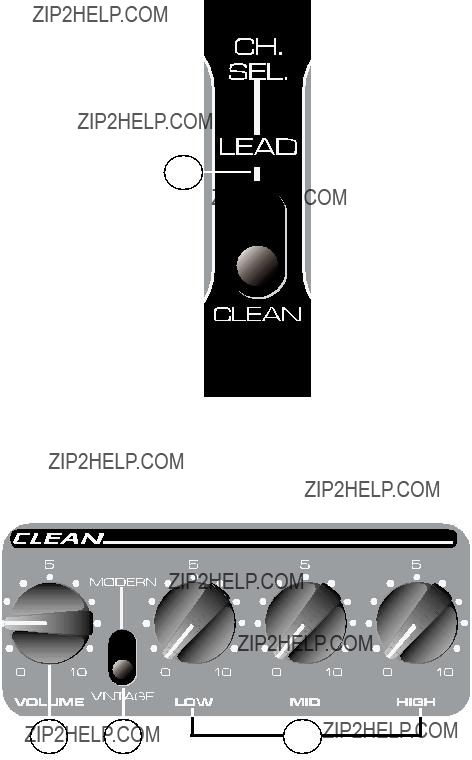
5.Entr??e de gain bas
Cette entr??e mono de 6,3 mm est con??ue pour les instruments ?? sorties extr??mement puissantes, qui peuvent provoquer une surcharge (distorsion) sur l???entr??e de gain ??lev?? (4). Si vous utilisez les entr??es de gains bas et ??lev?? simultan??ment, le niveau des deux sera bas.
CANAL
Votre ampli de la s??rie TransTube peut fonctionner sur deux canaux. Les canaux Clean (???son pur???) et Lead (???son meneur, arrang?????) constituent une
6
6.Commutateur de s??lection de canal
Le commutateur de s??lection de canal d??termine quel canal du pr??ampli TransTube, LEAD ou CLEAN, est actif. Ce commutateur doit se trouver sur ???LEAD??? pour permettre le fonctionnement de l???interrupteur au pied de votre ampli.
CANAL CLEAN
7.Volume
Cette commande r??gle le niveau de volume du canal Clean. Pour commencer, il est pr??f??rable de tourner compl??tement la commande dans le sens contraire antihoraire (gain minimum), et de la tourner ensuite dans le sens horaire pour atteindre le niveau souhait??.
27
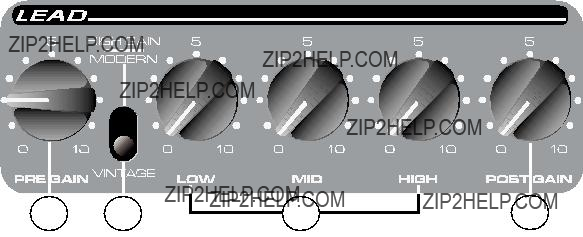
Apr??s avoir effectu?? tous les r??glages EQ et d???agencements sonores du canal, il est possible que vous souhaitiez r??initialiser cette commande.
8.Commutateur Modern/Vintage (Moderne/Mill??sim??)
Ce commutateur vous permet de changer instantan??ment l???agencement sonore pour reproduire les tonalit??s des amplificateurs modernes et mill??sim??s. La position MODERN produit un agencement sonore chaud et standard. La position Vintage change la fonction globale de l???EQ et ajoute une touche de clart?? pour imiter certains amplis classiques. Faites des essais avec ce commutateur et les r??glages Clean EQ (9) pour trouver la tonalit?? souhait??e. La section Mises au point recommand??es ?? la page 11 vous donnera quelques id??es de base pour faire preuve de cr??ativit??.
9.Clean EQ
La fonction TransTube EQ du canal Clean de votre ampli vous donne le choix entre 3 bandes de r??glages de tonalit??. Chaque commande EQ est passive (n???ajoute aucun gain) et poss??de une gamme de fr??quences qui d??pend de la position du commutateur Modern/Vintage. En mettant la commande en position ???0??? (tourner enti??rement dans le sens antihoraire), vous coupez compl??tement le niveau de la bande en question. Les bandes Basse, M??dium et Aigu servent ?? effectuer ces r??glages.
CANAL LEAD
10.Pre Gain
La commande Pre Gain r??gle le niveau d'entr??e du canal Lead. En tournant cette commande enti??rement dans le sens horaire, vous obtiendrez un gain maximum. Cette commande est souvent utilis??e pour r??gler la quantit?? de distorsion pr??sente dans le canal Lead.
11.Commutateur Modern/Vintage/High Gain (Moderne/Mill??sim??/Gain ??lev??)
Ce commutateur change ?? la fois le gain et l???agencement sonore du canal Lead. En s??lectionnant le r??glage MODERN, vous augmentez le gain g??n??ral et entaillez (coupez) les fr??quences moyennes pour produire un ton moderne souvent associ?? aux styles Hard Rock et Metal. La position VINTAGE utilise les circuits TransTube pour imiter les sons des tubes surcharg??s du pass??. Le r??glage HIGH GAIN augmente le gain g??n??ral et modifie l???EQ. Cela produit une r??ponse plus serr??e aux r??glages Pre Gain bas ou un son ???over the top??? aux r??glages Pre Gain ??lev??s. Faites des essais avec ce commutateur, tout en r??glant le Lead EQ (12), pour trouver la tonalit?? souhait??e. La section Mises au point recommand??es ?? la page 11 vous donnera quelques id??es de base pour faire preuve de cr??ativit??.
28

12.Lead EQ
La fonction TransTube EQ du canal Lead de votre ampli vous donne le choix entre 3 bandes de r??glages de tonalit??. Chaque commande EQ est passive (n???ajoute aucun gain) et poss??de une gamme de fr??quences qui d??pend de la position du commutateur Modern/Vintage/High Gain. En mettant la commande en position ???0??? (tourner enti??rement dans le sens antihoraire), vous coupez au maximum le niveau de la bande en question. Les bandes Basse, M??dium et Aigu servent ?? effectuer ces r??glages.
13.Post Gain
Cette commande sert ?? r??gler le niveau g??n??ral du canal Lead une fois que vous avez trouvez votre tonalit??. Pour commencer, il est pr??f??rable de tourner compl??tement la commande dans le sens antihoraire (gain minimum), et de la tourner ensuite dans le sens horaire jusqu'?? atteindre le niveau souhait??. Apr??s avoir effectu?? les r??glages EQ et d???agencement sonore du canal, il est possible que vous souhaitiez r??initialiser cette commande.
SECTION MASTER
Les sections Master des amplis de la s??rie TransTube varient selon le type d???appareil.
14.Reverb
La commande Reverb r??gle le niveau g??n??ral de la r??verb??ration. Cette commande se trouve sur les trois mod??les. Remarque: La reverb peut ??tre supprim??e ?? l'aide du commutateur ?? distance (18) sur les mod??les Envoy 110 et Studio Pro 112.
15.
Cette commande r??gle le niveau de puissance de l???amplificateur de 10 ?? 100 pour cent. Pour les niveaux inf??rieurs, la simulation de la compression de puissance sera beaucoup plus prononc??e. Cette commande se trouve sur le Studio Pro 112 et le Bandit 112.
16.Pr??sence (rondeur du son)
Cette commande de tonalit?? active amplifie les fr??quences extr??mement ??lev??es d???un maximum de 6 dB. Cette commande se trouve uniquement sur le Bandit 112.
17.R??sonance
Ce commutateur r??gle la r??sonance ?? basse fr??quence de l???enceinte acoustique en faisant varier le facteur d???amortissement de l???amplificateur de deux fa??ons: TIGHT (serr??) et LOOSE (d??tendu). En position TIGHT, l???amplificateur poss??de un facteur d???amortissement ??lev??, et par cons??quent la combinaison
29

coffre sert ?? donner plus de basses aux fins des sons, simulant l???effet d???un plus grand coffre. Cette commande se trouve uniquement sur le Bandit 112.
PANNEAU ARRI??RE
Les fonctions du panneau arri??re des amplis de la s??rie TransTube varient suivant les appareils. Veuillez les lire attentivement. Chaque description de fonction indique le(s) mod??le(s) correspondant(s).
18.Commutateur ?? distance
Cette prise accepte l???interrupteur ?? distance au pied de votre ampli. L???interrupteur au pied (en option sur les mod??les Envoy 110 et Studio Pro 112) est de type multifonction. Il sert ?? s??lectionner les canaux Clean ou Lead. En outre, l???interrupteur au pied est utilis?? pour activer/d??sactiver la reverb sur les mod??les Envoy 110 et Studio Pro 112. Sur le Bandit, l???interrupteur au pied (inclus) permet de s??lectionner le canal et de supprimer la boucle ?? effets. Le commutateur de s??lection de canal (6) doit se trouver en position LEAD pour que le commutateur ?? distance fonctionne.
19.Prise pour casques
Cette prise st??r??o de 6,3 mm accepte une paire d?????couteurs standard. L???utilisation de cette prise supprime la sortie vers le
REMARQUE: Les autres fonctions ne concernent que les mod??les Studio Pro 112 et/ou Bandit 112.
30
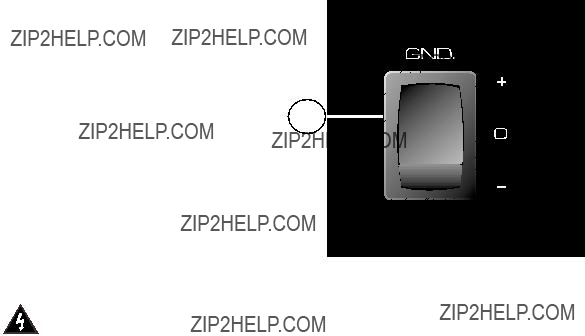
20.Boucle ?? effets
Cette paire de prises mono de 6,3 mm produit un parcours SEND (Envoi) et RETURN (Retour) des effets pour le signal du pr??ampli. Brancher la prise SEND ?? l???entr??e du mat??riel de traitement de signal externe ?? faible niveau (effets). Renvoyez le signal de votre mat??riel externe vers la prise RETURN. Ceci est appel?? ???boucle ?? effets??? car le signal sort de votre ampli (envoi) et revient en boucle (retour) vers ce m??me ampli. Sur le Bandit 112, la boucle ?? effets peut ??tre permut??e vers l???int??rieur et vers l???ext??rieur du parcours du signal ?? l???aide du commutateur ?? distance (18).
21.Prise pour
Cette prise de 6,3 mm sert ?? brancher un coffre de
REMARQUE: Les autres fonctions ne concernent que le mod??le Bandit 112.
22.Preamp Out (Sortie de pr??ampli)
Le Preamp Output sert ?? acheminer le signal du pr??ampli vers une console de mixage, un enregistreur ?? bandes, etc. A l???aide d???un c??ble d???instrument blind?? muni de fiches mono de 6,3 mm, branchez le Preamp Output ?? l???entr??e de votre mat??riel externe. Ce patch n???affecte pas le fonctionnement normal de votre amplificateur.
23.Power Amp In (Alimentation ampli entr??e)
Branchez les signaux de niveau de ligne du mat??riel externe ?? cette entr??e. En ins??rant une fiche dans cette prise mono de 6,3 mm, vous emp??cherez la transmission du signal du pr??ampli TransTube vers l???amplificateur. Dans cette configuration, l???ampli de puissance n???affecte que le signal introduit dans la prise Power Amp In.
24.Niveau d'effets
Ce commutateur permet de s??lectionner le niveau de fonctionnement de la boucle ?? effets (20). Lorsque vous mettez le commutateur en position ???in???, le niveau est r??gl?? pour 0 dBV (1 V RMS). En pla??ant le commutateur en position ???out???, le niveau passe ??
(0.3 V RMS). Veuillez vous reporter au manuel de l???utilisateur pour que les effets externes d??terminent la position correcte de ce commutateur.
25
25.Interrupteur de mise ?? la terre
Placez cet interrupteur de mise ?? la terre en position centrale (0) durant le fonctionnement normal. Si vous entendez un ronflement, positionnez l???interrupteur de mise ?? la terre en position positive (+) ou n??gative
31
REMARQUE: Si le probl??me de bruit persiste, consultez un revendeur Peavey agr???? ou le centre de r??paration Peavey. L???INTERRUPTEUR DE MISE A LA TERRE NE FONCTIONNE PAS SUR LES MODELES DE 220/240 VOLT.
ENVOY?? 110
SPECIFICATIONS
SECTION AMPLIFICATEUR DE PUISSANCE: Puissance au point de saturation: (en g??n??ral)
(5% THD, 1 kHz, ligne CA 120V) 40W RMS en 6 Ohms
R??ponse de fr??quence:
+0,
Entr??e de gain bas du pr??ampli:
Imp??dance: High Z, 44k Ohms Nominal Input Level (Niveau d???entr??e
nominal):
maximal): +6dBV, 2V RMS
Ronflement et bruit:
Plus de
Consommation d'??nergie:
75W ?? 60 Hz, 120V CA, Domestique
75W ?? 50/60 Hz,
Exportation
SECTION PR??AMPLI:
Les sp??cifications
S??lection de canal, Clean Commutateur de mode Clean, Modern Basse et Aigu ?? 10
M??dium ?? 0
Lead Pre et Post Gain ?? 10 Commutateur de mode Lead, Vintage Reverb ?? 0
Niveaux nominaux avec volume Clean ?? 5 Niveaux minimaux avec volume Clean ?? 10
Entr??e de gain ??lev?? du pr??ampli:
Imp??dance: High Z, 250 K Ohms Nominal Input Level (Niveau d???entr??e
nominal):
minimal):
maximal): +0 dBV, 1V RMS
Headphone Output (Sortie casque):
Imp??dance de charge: 16 Ohms ou plus Nominal Output Level (Niveau de sortie
nominal):
Syst??me de ronflement et de bruit au niveau d'entr??e nominal:
(20 Hz ?? 20 kHz non pond??r??)
Plus de 78 dB en dessous de la puissance nominale
Correction:
Sp??ciale basse, m??dium et aigu passive de type EQ (?? ??qualiseur ??).
Commutateur Modern/Vintage (Clean): Deux agencements sonores EQ diff??rents.
Commutateur Modern/Vintage/High Gain: Trois agencements sonores EQ et Gain diff??rents
Fonctions de l???interrupteur ?? pied externe:
S??lection: S??lection canal Clean ou Lead.
Reverb: D??rivation de reverb
Dimensions (H x L x P):
16" H x 18,13" W x 9,5" D 40,1cm x 46,1cm x 24,1cm
Poids:
21,7 lbs. (9,84 kg)
32
STUDIO PRO 112
SPECIFICATIONS
SECTION AMPLIFICATEUR DE PUISSANCE: Puissance et charge nominales:
Les sp??cifications de puissance sont mesur??es avec
65W RMS en 8 Ohms
Puissance au point de saturation: (en g??n??ral)
(5% THD, 1 kHz, ligne CA 120V)
65W RMS en 8 Ohms
R??ponse de fr??quence:
+3,
Entr??e de gain bas du pr??ampli:
Imp??dance: High Z, 44 k Ohms Nominal Input Level (Niveau d'entr??e
nominal):
maximal): +6 dBV, 2V RMS
Effects Send (Envoi effets):
Imp??dance de charge: 1k Ohms ou plus Nominal Output Level (Niveau de sortie
nominal):
Niveau d'effets
Ronflement et bruit:
Plus de 88 dB en dessous de la puissance nominale
Consommation d?????nergie:
200W ?? 60 Hz, 120V CA, Domestique
200W ?? 50/60 Hz,
Exportation
Effects Return (Retour effets):
Imp??dance: High Z, 22k Ohms Designed Input Level (Niveau d'entr??e
pr??vue):
Niveau d'effets
SECTION PR??AMPLI:
Les sp??cifications
S??lection de canal, Clean Commutateur de mode Clean, Modern Basse et aigu ?? 10
M??dium ?? 0
Lead Pre et Post Gain ?? 10 Commutateur de mode Lead, Vintage Reverb ?? 0
Niveaux nominaux avec volume Clean ?? 5 Niveaux minimaux avec volume Clean ?? 10
Entr??e de gain ??lev?? du pr??ampli:
Imp??dance: High Z, 250 K Ohms Nominal Input Level (Niveau d???entr??e
nominal):
minimal):
maximal): +0 dBV, 1V RMS
Syst??me de ronflement et de bruit au niveau d???entr??e nominal:
(20Hz ?? 20kHz non pond??r??)
Plus de 74 dB en dessous de la puissance nominale
Correction:
Sp??ciale basse, m??dium et aigu passive de type EQ (?? ??qualiseur ??)
Commutateur Modern/Vintage (Clean): Deux agencements sonores EQ diff??rents
Commutateur Modern/Vintage/High Gain: Trois agencements sonores EQ et Gain diff??rents
Fonctions de l???interrupteur ?? pied externe:
S??lection: S??lection canal Clean ou Lead
Reverb: D??rivation de reverb
Dimensions (H x L x P):
18" x 21,5" x 10,5" 45,7cm x 54,6cm x 26,7cm
Poids:
34,1 lbs. (15,47kg)
33
BANDIT?? 112
SPECIFICATIONS
SECTION AMPLIFICATEUR DE PUISSANCE:
Puissance et charge nominales:
Les sp??cifications de puissance sont mesur??es avec
80W RMS en 8 Ohms
100W RMS en 4 Ohms
Puissance au point de saturation: (en g??n??ral)
(5% THD, 1 kHz, ligne CA 120V)
80W RMS en 8 Ohms
100W RMS en 4 Ohms
R??ponse de fr??quence:
+0,
Ronflement et bruit:
Plus de 88 dB en dessous de la puissance nominale
Consommation d?????nergie:
300W ?? 60 Hz, 120V CA, Domestique
300W ?? 50/60 Hz,
Exportation
Section Pr??ampli:
Les sp??cifications
S??lection de canal, Clean Commutateur de mode Clean, Modern Basse et aigu ?? 10
M??dium ?? 0
Lead Pre et Post Gain ?? 10 Commutateur de mode Lead, Vintage Reverb ?? 0
Niveaux nominaux avec volume Clean ?? 5 Niveaux minimaux avec volume Clean ?? 10
Entr??e de gain ??lev?? du pr??ampli:
Imp??dance: High Z, 250 K Ohms Nominal Input Level (Niveau d???entr??e
nominal):
minimal):
maximal): +0 dBV, 1V RMS
Entr??e de gain bas du pr??ampli:
Imp??dance: High Z, 44 k Ohms Nominal Input Level (Niveau d'entr??e
nominal):
minimal):
maximal): +6 dBV, 2 V RMS
Effects Send (Envoi effets):
Imp??dance de charge: 1 k Ohms ou plus Nominal Output Level (Niveau de sortie nominal):
Commutateur de niveau d???effets ???out???:
Commutateur de niveau d???effets ???in???: 0 dBV, 1V RMS
Effects Return (Retour effets):
Imp??dance: High Z, 22k Ohms
Designed Input Level (Niveau d???entr??e pr??vue): Commutateur de niveau d???effets ???out???:
Commutateur de niveau d???effets ???in???: 0dBV, 1V RMS
(Prise ?? commutation permet un branchement Effects Send ?? Effects Return, lorsqu???il n???est pas utilis??).
Sortie de pr??ampli:
Imp??dance de charge: 1 k Ohms ou plus Nominal Output Level (Niveau de sortie nominal): 0 dBV, 1V RMS
Entr??e d???ampli de puissance:
Imp??dance: High Z, 22k Ohms Designed Input Level (Niveau d'entr??e
pr??vue): 0 dBV, 1V RMS
(Prise ?? commutation permettant un branchement sortie de pr??ampli ?? entr??e d???ampli de puissance, lorsqu???il n???est pas utilis??).
Syst??me de ronflement et de bruit au niveau d'entr??e nominal:
(20 Hz ?? 20 kHz non pond??r??)
Plus de 78 dB en dessous de la puissance nominale
34
Correction:
Sp??ciale basse, m??dium et aigu passive de type EQ (?? ??qualiseur ??)
Commutateur Modern/Vintage (Clean): Deux agencements sonores EQ diff??rents
Commutateur Modern/Vintage/High Gain: Trois agencements sonores EQ et Gain diff??rents
Pr??sence: +6 dB ?? 5 kHz
R??sonance de pouss??e: +6 dB ?? fr??quence de r??sonance du coffre
Fonctions de l'interrupteur ?? pied externe:
S??lection: S??lection canal Clean ou Lead
Effets: D??rivation de boucle ?? effets
Dimensions (H x L x P):
19,75" x 23,63" x 11,5" 50,16cm x 60,02cm x 29,2cm
Poids:
43,9 lbs. (19,91 kg)
35

DEUTSCH
Envoy?? 110, Studio?? Pro 112 und Bandit?? 112
Transtube??
Herzlichen Gl??ckwunsch zum Kauf eines Peavey
In dieser Gebrauchsanleitung werden drei
ALLGEMEINE FUNKTIONEN
???High und Low
???Zwei unterschiedliche
???Separate
???
???
???
???
???Anschlussm??glichkeit eines Fu??schalters
ENVOY
???
???40
???
???Kopfh??rerbuchse
???Reverb- und Kanalwahl per Fu??schalter
STUDIO PRO
???
???65
???Effekte, Send und Return
???T.
???Externe Lautsprecherbuchse
???Reverb- und Kanalwahl per Fu??schalter
BANDIT
???
???100 Watt Verst??rker (80 Watt im eingebauten Lautsprecher)
???Einschleifweg f??r Effekte und Kanalwahl per Fu??schalter
???
36
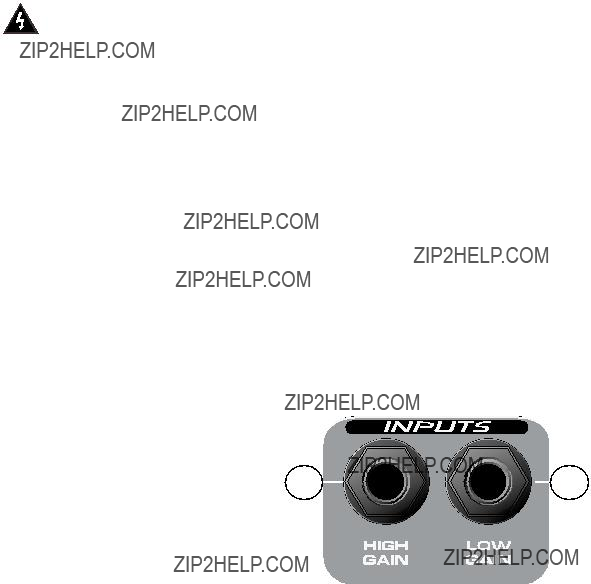
???
???
???Externe Lautsprecherbuchse
???
???
???
NETZANSCHLUSS
Bevor Sie Ihren
1.Netzkabel (im Geh??use)
In der hinteren Geh??use??ffnung, bei dem Lautsprecher, finden Sie das Netzkabel. Dieses Kabel ??bertr??gt die Netzspannung an das Ger??t. Verbinden Sie dieses Kabel mit einem richtig geerdeten Wechselstromanschluss. Ihr Verst??rker kann Schaden erleiden, wenn eine unkorrekte Spannungsleistung gew??hlt wird. (Sehen Sie dazu den Hinweis auf die Spannungsleistung an Ihrem Ger??t.) Enfernen Sie nie den Erdungskontakt von Ihrem Netzstecker.
2.Netzschalter (sehen Sie dazu im Abschnitt ???Master??? die Darstellung 7.)
Dr??cken Sie diesen Schalter auf ???ON???, um das Ger??t einzuschalten. Das
3.
Die aufleuchtende
Der
Eing??nge
Die Empfindlichkeit der Eing??nge Ihres
4.High
Das ist der
37

5.Low
Dieser 6,3 mm
Beide, der Clean- und der
6
6.
Der
7.Volume
Dieser Regler bestimmt das
38

8.
Mit diesem Schalter k??nnen Sie sehr schnell zwischen Voicings eines modernen und eines
9.
Der
10.Pre Gain
Der Pre
11.
Dieser Schalter ??ndert Gain und Voicing des
12.Lead EQ
Der
39

der ???0??? Position (gegen den Uhrzeigersinn bis zum Anschlag) reduzieren Sie maximal die Frequenz des jeweiligen Bandes.
13.Post Gain
Wenn Sie jetzt Ihre eigene Klangvorstellung eingestellt haben, ben??tzen Sie den Post Gain- Regler f??r die Settings des
Die
14.Reverb
Der
15.
Dieser Regler justiert den
16.Presence
Dieser aktive
17.Resonance
Der
40

R??CKSEITIGES BEDIENFELD
Die Funktionen auf dem r??ckseitigen Bedienfeld der
18.Fu??schalterbuchse
Diese Buchse ist der Eingang f??r den passenden Fu??schalter Ihres Verst??rkers. Der Fu??schalter (optional f??r Envoy 110 und Studio Pro 112) ist ein multifunktionales Ger??t. Sie w??hlen damit die Clean- und
19.Kopfh??rereingang
Sie k??nnen in diese 6,3
BEACHTEN SIE: Die verbleibenden Funktionen treffen nur f??r die Modelle Studio Pro 112 und/oder Bandit 112 zu.
20.Einschleifweg f??r Effekte
Diese zwei 6,3
41
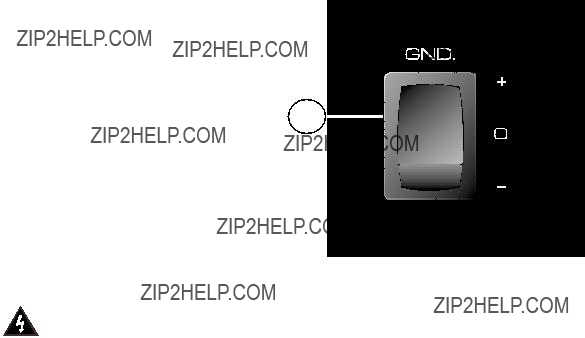
des externen,
21.Externe Lautsprecherbuchse
Die 6,3
BEACHTEN SIE: Die verbleibenden Funktionen treffen nur f??r das Modell Bandit 112 zu.
22.
Der
23.
24.
Der
25
25.
F??r den Normalbetrieb stellen Sie diesen Schalter in die Mittelpostition (0). Falls Sie ein Brummen h??ren, setzen Sie den
(+) oder in die
42
BEACHTEN SIE: Lassen sich die Ger??usche nicht beseitigen, sprechen Sie mit Ihrem Peavey- H??ndler. DER
Frequency Response:
+0,
Nominaler
Hum und Noise:
Mehr als
Stromverbrauch:
75W @ 60 Hz, 120V AC, f??r die USA
75W @ 50/60 Hz,
Die folgenden Spezifikationen wurden @ 1 kHz gemessen, mit folgenden Voreinstellungen:
Clean
Mid @ 0
Lead Pre und Post Gain @ 10 Lead
Nominaler Level mit Clean Volume @ 5
Preamp High
Impedanz: High Z, 250 K Ohm
Nominaler
System Hum und Noise @ Nominalem Input- Level:
(20 Hz bis 20 kHz unbewertet)
Mehr als 78 dB unterhalb der Nennleistung
Equalization:
Special Low, Mid und High passiv.
Externe
Select: Clean- oder
Reverb: Reverb Bypass
Ma??e (H x B x T):
16" H x 18,13" B x 9,5" T 40,1cm x 46,1cm x 24,1cm
Gewicht:
21,7 lbs, (9,84 kg)
43
STUDIO?? PRO 112
SPEZIFIKATIONEN
Power @ Clipping: (Standard)
(5% THD, 1 kHz, 120V
65W RMS in 8 Ohm
Frequency Response:
+3,
Hum und Noise:
Mehr als 88 dB unterhalb der Nennleistung
Stromverbrauch:
200W @ 60 Hz, 120V AC, in den USA
200W @ 50/60 Hz,
Die folgenden Spezifikationen wurden @ 1 kHz gemessen, mit folgenden Voreinstellungen:
Clean
Mid @ 0
Lead Pre und Post Gain @ 10 Lead
Nominaler Level mit einem Clean Volume @ 5
Preamp High
Impedanz: High Z, 250 K Ohm
Nominaler
Effects Send:
Nominaler
Effects Return:
Impedanz: High Z, 22k Ohm Designed
Effects Level
(Buchse mit Schalter stellt eine Verbindung zwischen
System Hum und Noise @ Nominalem
(20 Hz bis 20 kHz unbewertet)
Mehr als 74 dB unterhalb der Nennleistung
Equalization:
Special Low, Mid, und High passiv
getrennte
Drei verschiedene EQ- und Gain- Voicings
Externe
Select: Clean- oder
Reverb: Reverb Bypass
Ma??e (H x B x T):
18" x 21,5" x 10,5" 45,7cm x 54,6cm x 26,7cm
Gewicht:
34,1 lbs. (15,47kg)
44
BANDIT?? 112
SPEZIFIKATIONEN
Nennleistung und Belastung:
80W RMS in 8 Ohm
100W RMS in 4 Ohm
Effects Send:
Effects
Effects
Power @ Clipping: (Standard)
(5% THD, 1 kHz, 120V
80W RMS in 8 Ohm
100W RMS in 4 Ohm
Frequency Response:
+0,
Hum und Noise:
Mehr als
Stromverbrauch:
300W @ 60 Hz, 120V AC, f??r die USA
300W @ 50/60 Hz,
Die folgenden Spzifikationen wurden @ 1 kHz gemessen, mit folgenden Voreinstellungen:
Clean
Mid @ 0
Lead Pre und Post Gain @ 10 Lead
Nominale Level mit Clean Volume @ 5
Preamp High
Impedanz: High Z, 250 K Ohm
Nominaler
Effects Return:
Impedanz: High Z, 22k Ohm Designed
Effects
Effects
Preamp Output:
Nominaler
Power Amp Input:
Impedanz: High Z, 22k Ohm
Designed
System Hum und Noise @ Nominalem Input- Level:
(20 Hz bis 20 kHz unbewertet)
Mehr als 78 dB unterhalb der Nennleistung
Equalization:
Special Low, Mid und High passiv
getrennte
Drei verschiedene EQ- und
Push Resonance: +6 dB @ Resonanzfrequenz, Cabinet
Preamp Low
Impedanz: High Z, 44 k Ohm
Nominaler
Externe
Select: Clean oder
Effects:
Ma??e (H x B x T):
19,75" x 23,63" x 11,5" 50,16cm x 60,02cm x 29,2cm
Gewicht:
43,9lbs. (19,91kg)
45
IMPORTANT SAFETY INSTRUCTIONS
WARNING: When using electric products, basic cautions should always be followed, including the following:
1.Read these instructions.
2.Keep these instructions.
3.Heed all warnings.
4.Follow all instructions.
5.Do not use this apparatus near water. For example, near or in a bathtub, swimming pool, sink, wet basement, etc.
6.Clean only with a damp cloth.
7.Do not block any of the ventilation openings. Install in accordance with manufacturer???s instructions. It should not be placed or placed in a
8.Do not install near any heat sources such as radiators, heat registers, stoves or other apparatus (including amplifiers) that
9.Do not defeat the safety purpose of the polarized or
booklet ???Shock Hazard and Grounding???. Connect only to a power supply of the type marked on the unit adjacent to the power suppl
10.Protect the power cord from being walked on or pinched, particularly at plugs, convenience receptacles, and the point they e
apparatus.
11.Only use attachments/accessories provided by the manufacturer.
12.Use only with a cart, stand, tripod, bracket, or table specified by the manufacturer, or sold with the apparatus. When a when moving the cart/apparatus combination to avoid injury from
13.Unplug this apparatus during lightning storms or when unused for long periods of time.
14.Refer all servicing to qualified service personnel. Servicing is required when the apparatus has been damaged in any way,
supply cord or plug is damaged, liquid has been spilled or objects have fallen into the apparatus, the apparatus has been expos moisture, does not operate normally, or has been dropped.
15.If this product is to be mounted in an equipment rack, rear support should be provided.
16.Exposure to extremely high noise levels may cause a permanent hearing loss. Individuals vary considerably in susceptibili hearing loss, but nearly everyone will lose some hearing if exposed to sufficiently intense noise for a sufficient time. The U. Occupational and Health Administration (OSHA) has specified the following permissible noise level exposures:
According to OSHA, any exposure in excess of the above permissible limits could result in some hearing loss. Ear plugs or prote canals or over the ears must be worn when operating this amplification system in order to prevent a permanent hearing loss, if
of the limits as set forth above. To ensure against potentially dangerous exposure to high sound pressure levels, it is recomme exposed to equipment capable of producing high sound pressure levels such as this amplification system be protected by hearing this unit is in operation.
SAVE THESE INSTRUCTIONS!
flat against a wall
produce heat.
the other. A the provided
. Write for our free y cord.
xit from the
cart is used, use caution
such as power-
ed to rain or
ty to
ctors to the ear exposure is in excess
nded that all persons protectors while
46

PEAVEY ELECTRONICS CORPORATION LIMITED WARRANTY
Effective Date: July 1, 1998
Limitation of Implied Warranties
ANY IMPLIED WARRANTIES, INCLUDING WARRANTIES OF MERCHANTABILITY AND FITNESS FOR A PARTICULAR PURPOSE, ARE LIMITED
IN DURATION TO THE LENGTH OF THIS WARRANTY.
Some states do not allow limitations on how long an implied warranty lasts, so the above limitation may not apply to you.
Features and specifications subject to change without notice.
47
